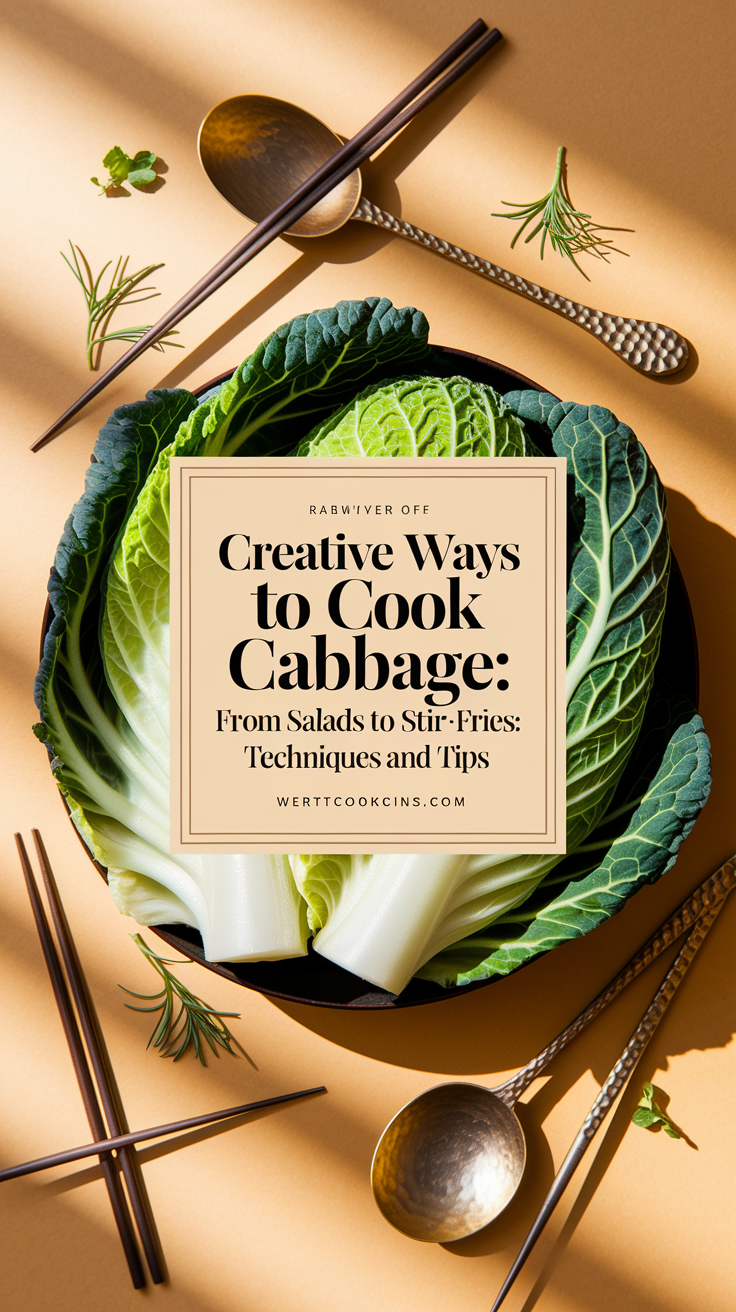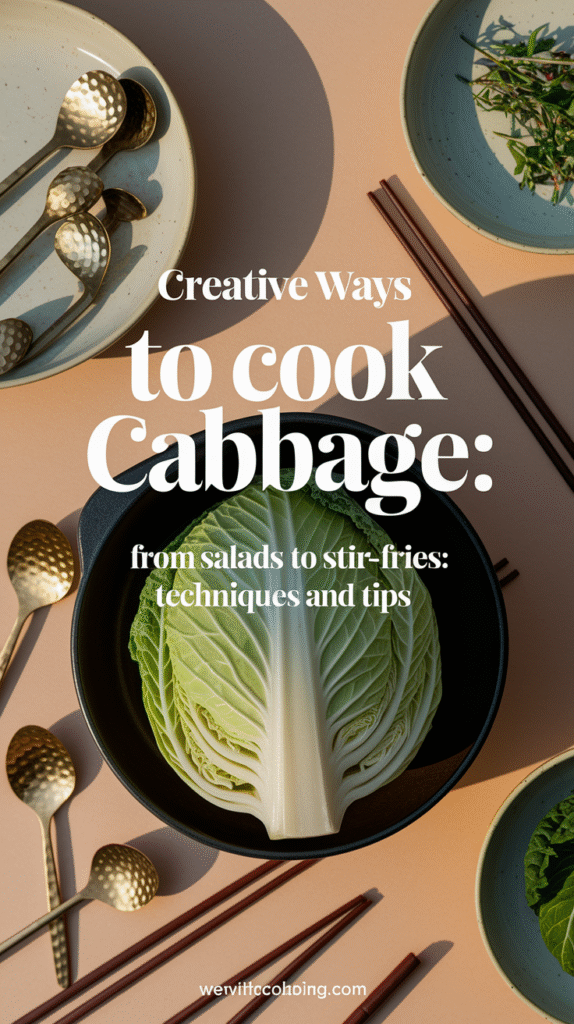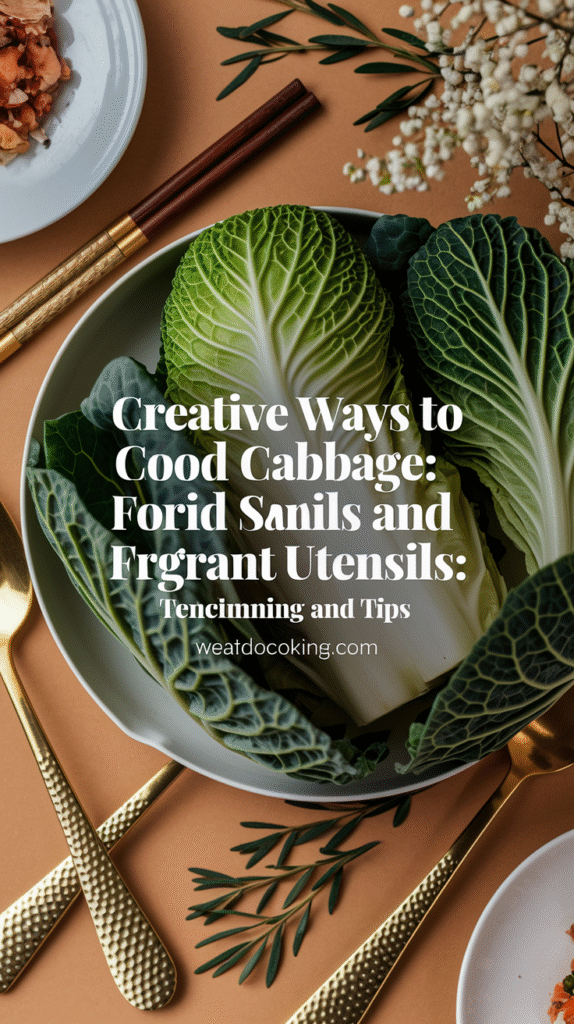Cabbage is a versatile vegetable packed with nutrients and can be enjoyed in various dishes. Whether you’re whipping up a fresh salad, satisfying stir-fry, or even a delicious soup, cabbage can be your trusty sidekick. Here are some creative ways to cook cabbage that can elevate your meals.
Salads that Pop
Cabbage salads are colorful and refreshing. You can mix green and red cabbage for a vibrant look. Here are a few variations:
- Coleslaw: This classic dish is a perfect side for barbecues. Combine shredded cabbage, carrots, and a tangy dressing made from mayonnaise, vinegar, sugar, salt, and pepper.
- Cabbage and Apple Salad: Add some sliced apples and walnuts for a crunch. A honey mustard vinaigrette ties the flavors together.
- Asian Cabbage Salad: Incorporate sesame oil, soy sauce, and rice vinegar with shredded cabbage, cilantro, and crunchy noodles for an Asian twist.
Stir-Fries
Stir-frying cabbage is quick and effective, making it a great addition to your weekday dinner. Here’s a simple stir-fry recipe:
- Simple Stir-Fried Cabbage: Heat some oil in a large skillet or wok. Add sliced cabbage, garlic, and onion. Stir-fry for about 5 minutes. Season with soy sauce and sesame seeds for extra flavor.
- Cabbage and Beef Stir-Fry: Cook strips of beef until browned. Add shredded cabbage, bell peppers, and a splash of oyster sauce. This meal is hearty and can be served over rice or noodles.
Soups and Stews
Cabbage adds depth to soups and stews. It’s a perfect way to warm up during colder months:
- Cabbage Soup: Combine vegetable broth, diced tomatoes, onions, carrots, and shredded cabbage. Season with herbs like thyme and bay leaf. Let it simmer until the cabbage is tender.
- Hearty Cabbage Stew: Throw in potatoes, carrots, and sausage for a robust meal. Let everything simmer in a rich broth for a satisfying dish.
Roasted Cabbage Steaks
Roasting cabbage brings out its natural sweetness. Here’s how to make cabbage steaks:
- Preheat your oven to 400°F (200°C).
- Slice the cabbage into thick rounds, about 1 inch each.
- Brush both sides with olive oil, then sprinkle salt, pepper, and any herbs or spices you like (paprika, garlic powder, and parmesan work great).
- Place on a baking sheet and roast for 25-30 minutes until the edges are crispy.
Fermented Delights
Cabbage is also perfect for fermentation. Making your own sauerkraut or kimchi can provide probiotics beneficial for your gut health:
- Sauerkraut: Shred some cabbage and mix with salt. Pack it tightly into a jar, allowing the natural juices to create a brine. Let it ferment for 1-4 weeks.
- Kimchi: Spicy fermented cabbage made with chili powder, garlic, ginger, and fish sauce. It’s vibrant, crunchy, and perfect for adding a kick to your dishes.
Cabbage in Wraps and Rolls
Cabbage leaves are great for wraps and rolls. They can be a low-carb alternative to tortillas:
- Stuffed Cabbage Rolls: Fill cooked cabbage leaves with a mixture of ground meat, rice, and herbs. Bake in a tomato sauce for a comforting meal.
- Cabbage Wraps: Use raw cabbage leaves to wrap up various fillings like grilled chicken, veggies, or hummus for a healthy option.
Cabbage is not just a side dish; it can be the star of your meal. Explore these cooking methods to unlock its full potential. For more in-depth recipes and ideas, check out Love & Lemons and Food Network.
With its health benefits and versatility, cooking cabbage has never been more exciting. Try these innovative recipes to delight your family and friends!
The Nutritional Benefits of Including Cabbage in Your Diet
Cabbage is often overlooked in the vegetable world, but it packs a powerful punch when it comes to nutrition. This leafy green vegetable is not only versatile in the kitchen but also rich in vitamins and minerals that are crucial for maintaining good health. If you’re looking to enhance your diet, including cabbage can be a fantastic choice.
One of the standout features of cabbage is its low calorie content. A cup of raw cabbage contains just about 22 calories. This makes it an excellent option for weight management while still providing essential nutrients. Furthermore, it is rich in dietary fiber, which promotes healthy digestion and helps keep you full, potentially aiding in weight loss efforts.
Here are some key nutritional components that cabbage offers:
- Vitamin C: Cabbage is an excellent source of Vitamin C, crucial for immune function, skin health, and overall well-being. A cup of chopped cabbage can provide about 85% of your daily recommended intake.
- Vitamin K: This vitamin is important for bone health and blood clotting. Cabbage is one of the best sources, with a single serving providing around 45% of the recommended daily amount.
- Folate: Folate is vital during pregnancy for fetal development and can help reduce the risk of some birth defects. Cabbage contains a decent amount of this important B vitamin.
- Antioxidants: Cabbage is rich in antioxidants, which can help prevent cell damage and reduce inflammation in the body.
Cabbage into your meals can be both delicious and simple. Here are several ways to prepare and enjoy this nutritious vegetable:
- Raw: Adding chopped cabbage to salads or coleslaw is a refreshing way to enjoy its crisp texture and nutritional benefits.
- Cooked: You can sauté, steam, or stir-fry cabbage. Cooking can help improve its digestibility while maintaining most of its nutrients.
- Fermented: Fermented cabbage, like sauerkraut or kimchi, not only enhances flavor but also gives you probiotics, which are beneficial for gut health.
Not only is cabbage nutritious, but it is also linked to various health benefits. Regular consumption of cabbage may help reduce the risk of chronic diseases such as heart disease and certain cancers. This vegetable is rich in glucosinolates, compounds that may have cancer-preventing properties.
Another impressive feature of cabbage is its anti-inflammatory properties. The presence of antioxidants, along with factors like Vitamin K and U, makes it a good choice to keep inflammation at bay. This can be particularly helpful for individuals suffering from arthritis or other inflammatory conditions.
Cabbage is also a natural detoxifier. Its high fiber content aids in digestion and promotes a healthy gut, while certain compounds in cabbage support liver function. This is essential for your body’s natural detoxification processes.
To visualize just how beneficial cabbage can be, consider the following nutrients per 100 grams of raw cabbage:
| Nutrient | Amount | % Daily Value |
|---|---|---|
| Calories | 25 | 1% |
| Vitamin C | 36.6 mg | 61% |
| Vitamin K | 76 mcg | 64% |
| Folate | 61 mcg | 15% |
| Fiber | 2.5 g | 10% |
Cabbage into your diet is straightforward. Many local markets or grocery stores carry varieties such as green, red, or Savoy cabbage. Their versatility in dishes—from soups and stews to slaws and wraps—makes them easy to include in your weekly meal plan.
With so many advantages, it’s clear that cabbage should not be neglected. To explore more about the health benefits of cabbage and other vegetables, consider checking out resources like Healthline and WebMD. Embrace this nutritious vegetable and reap the myriad of health benefits it has to offer!
Exploring Different Varieties of Cabbage and Their Uses
Cabbage is not just a single type of vegetable; it embodies a wide range of varieties, each providing unique flavors, textures, and nutritional benefits. Understanding the different types of cabbage and their uses can elevate your cooking game, allowing you to create more diverse and nutritious meals.
Green Cabbage
Green cabbage is perhaps the most common variety you’ll find in grocery stores. Its tightly packed leaves have a crisp texture and a mild flavor. It’s versatile enough to be used in salads, slaws, stir-fries, and soups.
- Uses: Great for coleslaw, sautéing, or even as a wrap for fillings.
- Cooking Tip: To enhance sweetness, try roasting it!
Red Cabbage
Red cabbage is not just a pretty face. Its vibrant color not only adds visual appeal but also indicates a rich source of antioxidants. It tends to have a slightly peppery flavor compared to its green counterpart.
- Uses: Best for salads, pickling, or braising. It can also be used to color rice or other dishes.
- Cooking Tip: Pairing with apple or citrus can balance its flavor nicely.
Napa Cabbage
Napa cabbage, sometimes called Chinese cabbage, has a milder taste and a more delicate texture. Its elongated leaves make it popular in Asian cuisine.
- Uses: Perfect for stir-fries, kimchi, or as a wrapping for dumplings.
- Cooking Tip: Enjoy it raw in salads for a fresh crunch!
Savoy Cabbage
With its crinkled leaves and tender texture, Savoy cabbage offers a gentler flavor profile. It is softer and more delicate than green and red cabbage, making it an excellent choice for various dishes.
- Uses: Ideal for soups, sautéing, or stuffed cabbage rolls.
- Cooking Tip: Try to lightly steam it to retain its texture without losing nutrients.
Brussels Sprouts
Though often categorized separately, Brussels sprouts are miniature cabbages packed with flavor and nutrition. They thrive when roasted or sautéed, enhancing their natural sweetness.
- Uses: Great roasted with olive oil, added to salads, or even used in casseroles.
- Cooking Tip: Finishing with balsamic glaze can bring out their best flavors.
| Type of Cabbage | Flavor Profile | Best Uses |
|---|---|---|
| Green Cabbage | Mild | Salads, stir-fries, soups |
| Red Cabbage | Peppery | Salads, pickling |
| Napa Cabbage | Mild | Stir-fries, kimchi |
| Savoy Cabbage | Gentle | Soups, stuffed dishes |
| Brussels Sprouts | Sweet | Roasted, salads |
As you explore the culinary world of cabbage, consider its health benefits as well. Cabbage is rich in vitamins C and K and is a low-calorie food that can help in maintaining a balanced diet. different varieties not only boosts your meal’s nutritional value but also keeps your palate excited. For more detailed recipes and tips on cooking cabbage, visit Food Network or explore comprehensive guides at Serious Eats.
Whether you’re shredding green cabbage for a crunchy salad or braising red cabbage for a warming side dish, each variety holds unique characteristics that can enhance your meals. So next time you’re at the market, don’t hesitate to try a new type of cabbage and discover the wonderful versatility that awaits you in your kitchen.
Tips for Preparing and Storing Cabbage for Maximum Freshness
When it comes to cooking cabbage, freshness is key. Cabbage is a versatile vegetable that can be used in salads, stir-fries, soups, and more. To enjoy it fully, knowing how to prepare and store cabbage while maintaining its freshness is essential. Here are some helpful tips to keep your cabbage crisp and flavorful.
Choosing the Right Cabbage
Start by selecting a high-quality cabbage. Look for a cabbage that is firm and heavy for its size. The leaves should be crisp, vibrant, and free from blemishes. Different types of cabbage, such as green, red, and Savoy, can be used interchangeably, but each has a distinct flavor and texture that works best in specific dishes.
Preparing Cabbage
Once you have chosen your cabbage, proper preparation is essential. Follow these steps:
- Wash Thoroughly: Rinse cabbage under cold water to remove any dirt or pesticide residues. Use a vegetable brush for extra cleanliness.
- Removing the Core: Place the cabbage on a cutting board. To remove the core, cut out a cone shape from the bottom with a sharp knife. Be careful not to take too much of the leaves.
- Cutting the Cabbage: Depending on how you plan to use it, slice the cabbage into wedges, shreds, or chop into bite-sized pieces. Aim for uniform cuts to ensure even cooking.
Cooking Methods
Cooking cabbage brings out its flavors and can alter its texture. Here are some common cooking methods:
- Boiling: Boiling cabbage is quick and easy. Boil water in a pot, add the cabbage, and cook for 5-10 minutes until tender.
- Steaming: Steaming helps to retain the nutrients in cabbage. Place the cabbage in a steam basket over boiling water, cover, and steam for about 5-7 minutes.
- Sautéing: For a flavorful option, sauté cabbage in a pan with olive oil, garlic, and spices. Cook for about 5-8 minutes, stirring frequently.
- Roasting: Roasting cabbage adds a nutty flavor. Cut the cabbage into wedges, drizzle with olive oil, season with salt and pepper, and roast in the oven at 400°F (205°C) for 20-30 minutes.
Storing Cabbage
Storing cabbage correctly helps maintain its freshness and prolong its shelf life. Here are some effective storage tips:
- Refrigeration: Store whole cabbage heads in the crisper drawer of your refrigerator. Keep them in an unsealed plastic bag or slightly open to allow air circulation.
- Cut Cabbage Storage: If you have cut cabbage, wrap it tightly in plastic wrap or place it in an airtight container. This will help keep it from drying out.
- Freezing Cabbage: For longer storage, you can freeze cabbage. Blanch it first by boiling for 2-3 minutes then plunge it in ice water before draining. Store in freezer bags, squeezing out excess air.
Using Leftover Cabbage
Don’t let leftover cabbage go to waste! Here are ways to use it:
- Make coleslaw by shredding cabbage and mixing it with a dressing of your choice.
- Add cabbage to smoothies for added fiber and nutrition.
- Incorporate it into stir-fries with other vegetables and proteins for a hearty meal.
For more detailed information on cooking cabbage and storing it, you can visit EatingWell for recipes and techniques, or check out Healthline for nutritional benefits.
By following these tips, you can maximize the freshness of your cabbage and enjoy its health benefits and delicious flavors in your cooking. Cabbage can be a robust part of your meals when prepared and stored properly!
Cultural Dishes Featuring Cabbage Around the World
Cabbage is a versatile vegetable that appears in an array of cultural dishes across the globe. From crunchy salads to hearty stews, cabbage has a unique ability to soak up flavors and enhance meals. Let’s explore some well-known dishes featuring cabbage around the world, showcasing its cultural significance and delightful variations.
Kimchi – South Korea
Kimchi is a traditional Korean dish that is beloved both locally and internationally. Made from fermented napa cabbage and a variety of seasonings, this dish offers a spicy, tangy flavor. The fermentation process not only enhances the taste but also boosts its health benefits, making it a staple in Korean cuisine.
Coleslaw – United States
Coleslaw is a classic American side dish often served at barbecues and picnics. It combines shredded cabbage, carrots, and a dressing, typically mayo-based or vinegar-based. The crunchiness of the cabbage pairs perfectly with grilled meats, making it a favorite summer dish.
Sauerkraut – Germany
Sauerkraut is finely cut fermented cabbage that has a distinctive sour taste. A key ingredient in German cuisine, it’s often served with sausages or used as a filling for sandwiches. The process of fermenting cabbage not only preserves it but also imparts a unique flavor that complements rich meats.
Golabki – Poland
Golabki, also known as stuffed cabbage rolls, feature cabbage leaves filled with a mixture of ground meat, rice, and spices. The rolls are then cooked in a tomato or mushroom sauce, resulting in a hearty dish that warms the soul. This Polish favorite is often enjoyed during family gatherings and celebrations.
Dolma – Turkey
Dolma are grape leaves stuffed with a mixture typically made of rice, pine nuts, and spices, but cabbage leaves can also be used. This dish reflects the culinary traditions of the Mediterranean and Middle Eastern regions. Dolma can be enjoyed warm or at room temperature, making them a versatile choice for any meal.
Rösti – Switzerland
Rösti is a Swiss potato dish that often incorporates cabbage for added texture and flavor. Although primarily a potato dish, the addition of cabbage makes it even heartier. Cheesy and crispy, rösti can be served as a side dish or a flavorful standalone offering.
Stamppot – Netherlands
Stamppot is a traditional Dutch dish made by mashing potatoes with various vegetables, including cabbage. It is commonly served with sausage, and its creamy texture combined with the slight crunch of cabbage makes it a comforting meal during the colder months.
Bubble and Squeak – United Kingdom
This British dish is a clever way to use leftover vegetables, often made from potatoes and cabbage. The name “Bubble and Squeak” is derived from the sounds the ingredients make while cooking in the pan. It’s typically served as a hearty breakfast or a side dish along with meats.
Recipe Ideas and Tips
If you’re inspired to incorporate more cabbage into your meals, here are a few cooking tips:
- Try roasting cabbage wedges with olive oil and spices for a caramelized flavor.
- Add shredded cabbage to soups for extra texture and nutrients.
- Use cabbage leaves as wraps instead of tortillas for a low-carb option.
- Stir-fry cabbage with your favorite vegetables and protein for a quick one-pan meal.
Learn more about Kimchi
Discover Coleslaw recipes
Get to know Sauerkraut
Explore Golabki preparation
Find out about Dolma
With its rich cultural significance and versatility, cabbage continues to inspire culinary creativity across many cultures. From beloved comfort foods to healthy options, this humble vegetable deserves a spot on your plate.
Conclusion
Cabbage is an incredibly versatile vegetable that can enhance every meal with its unique flavors and textures. From crisp salads and hearty stir-fries to comforting soups and global dishes, the creative ways to cook cabbage are endless. Not only is cabbage delicious, but it also comes packed with essential nutrients like vitamin C, fiber, and antioxidants, making it a powerhouse of health benefits that can support your overall well-being.
As you explore different varieties of cabbage—like green, red, and Savoy—you’ll discover new tastes and cooking methods that can elevate your culinary experiences. Each variety brings its own character, inviting you to experiment and find the ideal fit for your next dish. With just a little preparation know-how and proper storage tips, you can keep your cabbage fresh for longer, ensuring you always have this nutritious ingredient on hand.
Moreover, diving into cabbage-based dishes from various cultures expands your culinary horizons and introduces you to new flavors. Whether you’re enjoying kimchi from Korea or coleslaw from the United States, every bite delivers a taste of tradition and creativity.
So, whether you’re a seasoned cook or just starting your culinary journey, don’t overlook this humble vegetable. cabbage into your meals not only boosts nutrition but also opens a world of delicious possibilities. Embrace the journey of cooking cabbage, and enjoy all the flavors and health benefits it has to offer!







Leave a Reply